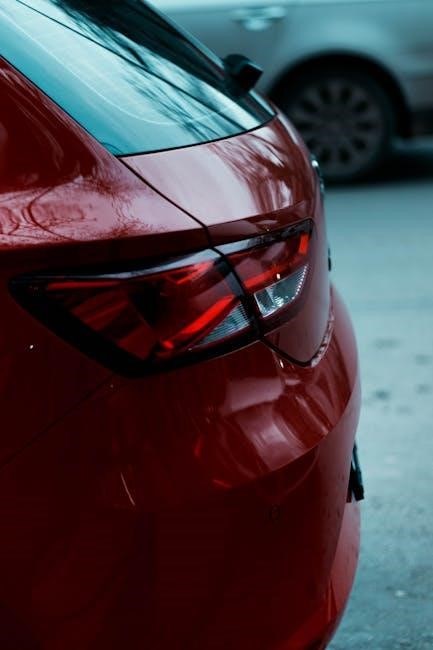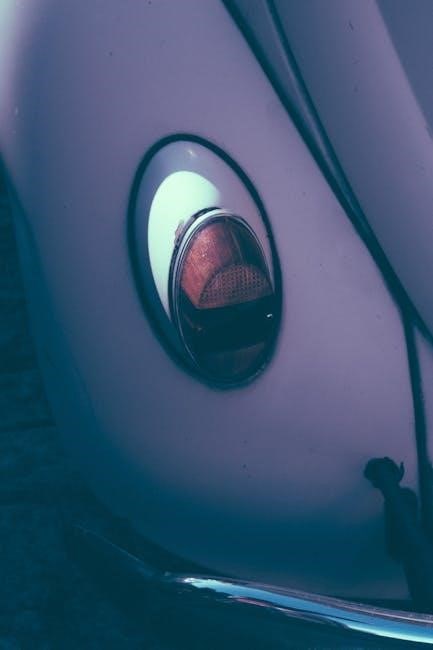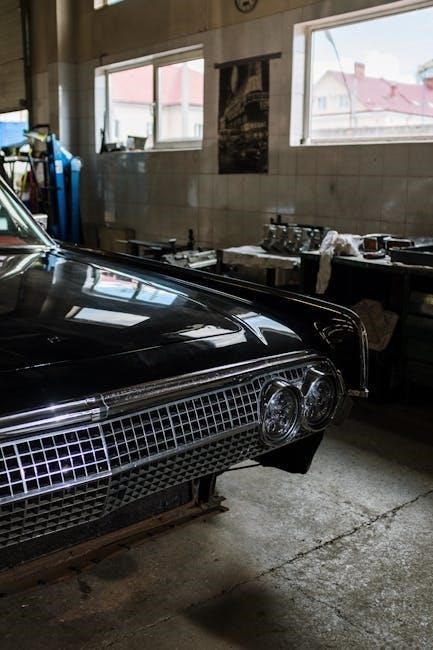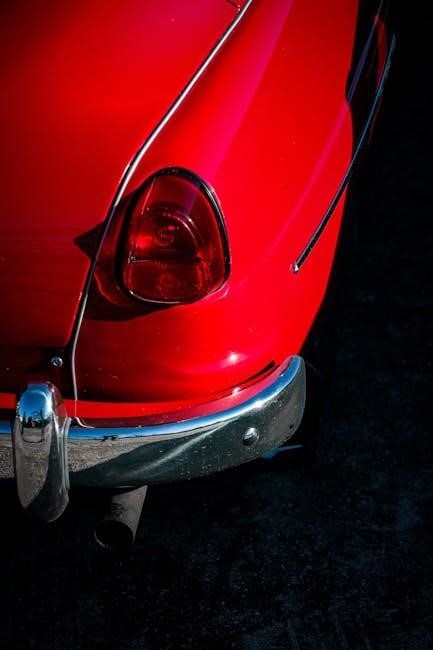Bumper guides are essential components that aid in aligning and positioning bumpers during installation. They ensure proper fitment and functionality, enhancing both safety and aesthetic appeal. Made from durable materials like plastic, metal, or composites, they are designed to withstand various environmental conditions. Their role in modern automotive design has evolved, incorporating advanced features such as sensors and cameras for improved performance. Proper mounting and alignment are crucial for optimal functionality, making them a vital part of vehicle maintenance and customization.
What Are Bumper Guides?
Bumper guides are specialized components designed to assist in the proper alignment and installation of vehicle bumpers. They help ensure accurate positioning and secure mounting, preventing misalignment issues. Typically made from durable materials like plastic or metal, these guides are essential for maintaining the structural integrity and aesthetic appeal of a vehicle’s bumper system. They are commonly used during repairs, replacements, or custom installations, providing a reliable reference point for technicians and DIY enthusiasts alike. By facilitating precise alignment, bumper guides play a crucial role in enhancing safety and reducing potential damage during low-speed impacts or parking maneuvers.
The Importance of Bumper Guides

Bumper guides are crucial for ensuring proper bumper alignment and installation, preventing misalignment that could lead to structural damage or safety hazards. They provide clear reference points, simplifying the installation process and reducing the risk of errors. By guiding the bumper into the correct position, they help maintain the vehicle’s aesthetic appeal and functional integrity. Additionally, bumper guides play a key role in enhancing safety by ensuring bumpers are securely mounted, which is vital for absorbing impacts and protecting the vehicle and its occupants. Their importance lies in their ability to streamline installation while safeguarding against potential damage.
Evolution of Bumper Guides in Automotive Design

Bumper guides have undergone significant evolution in automotive design, adapting to technological advancements and changing safety standards. Initially simple alignment tools, they now integrate advanced materials and features. Modern bumper guides often incorporate sensors and cameras, enhancing vehicle safety and functionality. Their design has become more precise, catering to diverse vehicle types and customization needs. This evolution reflects the automotive industry’s focus on innovation, safety, and aesthetic appeal, ensuring bumper guides remain a critical component in both functionality and design. Their development continues to align with the broader trends of automotive engineering.

Types and Classifications of Bumper Guides
Bumper guides are classified by their location, material, and functionality. They include front, rear, and side guides, each designed for specific purposes and vehicle types.
Front Bumper Guides
Front bumper guides are essential components designed to enhance vehicle safety and aerodynamics. They are typically made of durable materials like plastic or metal, ensuring longevity. These guides help align bumpers correctly, preventing misalignment issues. They also protect sensitive sensors and cameras integrated into modern bumpers. Front bumper guides are often tailored to specific vehicle models, ensuring a precise fit. Their design focuses on both functionality and aesthetics, contributing to a sleeker appearance. Regular maintenance, such as cleaning and inspecting for damage, is crucial for optimal performance. Properly installed front bumper guides improve safety and maintain the vehicle’s structural integrity over time.
Rear Bumper Guides
Rear bumper guides play a vital role in enhancing vehicle safety and functionality. Designed to provide structural support, they protect the rear bumper from damage during minor collisions or parking incidents. Typically made from durable materials like plastic or metal, these guides ensure longevity and resistance to wear. Rear bumper guides often feature integrated reflectors or sensors, improving visibility and aiding in parking maneuvers. They are tailored to fit specific vehicle designs, ensuring seamless integration. Regular maintenance, such as cleaning and inspecting for damage, is essential to maintain their effectiveness. Rear bumper guides contribute to both the aesthetic appeal and practical safety of a vehicle.
Side Bumper Guides
Side bumper guides are essential components designed to enhance vehicle safety and functionality; Positioned along the sides of the bumper, they provide additional protection against minor impacts, such as parking lot scrapes or low-speed collisions. These guides are typically constructed from durable materials like plastic or metal, ensuring resilience and longevity. Side bumper guides often feature sleek designs to complement the vehicle’s aesthetic while maintaining practicality. They are installed to align seamlessly with the vehicle’s body, offering both protective and visual benefits. Regular cleaning and inspection are recommended to maintain their effectiveness and appearance over time.

Materials Used in Bumper Guides
Bumper guides are crafted from high-quality materials such as plastic, metal, and composite blends, ensuring durability and impact resistance while maintaining a sleek, aerodynamic design.
Plastic Bumper Guides
Plastic bumper guides are lightweight, durable, and resistant to minor impacts, making them a popular choice for modern vehicles. They are often injection-molded for precision and flexibility, allowing them to absorb shocks without cracking. These guides are also cost-effective and easy to produce in large quantities. Additionally, plastic bumper guides can be finished with textures or colors to match the vehicle’s design, enhancing both functionality and aesthetics. Their weather-resistant properties ensure long-term performance, even in harsh conditions. Overall, plastic bumper guides strike a balance between practicality and style, making them a preferred option in automotive manufacturing.
Metal Bumper Guides
Metal bumper guides are known for their exceptional strength and durability, making them ideal for heavy-duty vehicles or those requiring enhanced protection. Typically made from stainless steel or aluminum, these guides offer superior resistance to corrosion and wear. They provide a robust structural support system, ensuring the bumper remains securely in place. Metal guides are also excellent at absorbing and redistributing impact forces, protecting critical vehicle components. However, they are heavier than plastic guides, which can affect fuel efficiency, and may be more expensive to produce and install. Despite this, their reliability and longevity make them a popular choice for rugged applications.
Composite Bumper Guides
Composite bumper guides combine materials like plastics and fibers to offer a balance of strength, flexibility, and lightweight construction. These guides are highly durable and resistant to corrosion, making them suitable for various environmental conditions. They provide excellent energy absorption during impacts while maintaining a sleek, modern appearance. Composite guides are often used in high-performance vehicles due to their ability to reduce overall weight without compromising safety. However, they can be more expensive to produce and may require specialized techniques for repair. Despite this, their versatility and performance make them a favored choice in contemporary automotive design.

Installation and Mounting
Installing bumper guides requires precise alignment and proper tools; Ensure compatibility with your vehicle’s make and model for accurate mounting. Follow manufacturer guidelines for secure placement.
How to Install Bumper Guides
Installing bumper guides involves several key steps for optimal performance. Start by gathering the necessary tools, such as a screwdriver or wrench, and ensure the vehicle is parked on a level surface. Remove any existing guides by unscrewing or popping them out, depending on the design. Clean the mounting area to ensure a secure fit. Align the new guides with the bumper’s pre-drilled holes or brackets, ensuring proper positioning. Tighten the screws or clips firmly but avoid overtightening, which may damage the bumper. Double-check alignment and test the guides by gently pushing or pulling the vehicle to ensure stability. Proper installation enhances safety and functionality.
Mounting Positions and Alignment
Proper mounting positions and alignment are crucial for bumper guides to function effectively. Guides are typically mounted at the corners or center of the bumper, depending on the vehicle’s design. Ensure they are evenly spaced and aligned with the vehicle’s frame for optimal performance. Use a ruler or alignment tool to verify straightness and symmetry. Misaligned guides can compromise safety and aesthetics. Refer to the manufacturer’s specifications for precise mounting locations. Double-check the alignment before securing the guides to ensure they are level and properly positioned for maximum efficiency and visual appeal.
Maintenance and Care
Regular cleaning with mild detergents prevents dirt buildup. Avoid abrasive materials to maintain finish. Inspect guides periodically for damage or wear. Prompt repairs ensure optimal functionality and safety.
Cleaning and Protection Tips

Regularly clean bumper guides with mild detergents and soft cloths to prevent dirt buildup. Avoid high-pressure washes, as they may damage finishes. For tougher stains, use a gentle scrubber but avoid abrasive materials. Apply a protective wax or sealant to shield against UV rays and environmental factors. Avoid using harsh chemicals or acidic cleaners, as they can degrade materials. Dry thoroughly after cleaning to prevent water spots. For painted or chrome finishes, use specialized products to maintain luster. Regular inspections ensure longevity and functionality, while prompt touch-ups address minor damage before it worsens.
Repairing Damaged Bumper Guides
Assess the damage first, addressing minor scratches with touch-up paint. For dents or misalignment, seek professional assistance. Severely damaged guides may need replacement, so consult your vehicle’s manual or a technician. After repairs, apply a protective coating to prevent future damage. Regular maintenance can prevent minor issues from escalating. Specialized tools may be required for proper alignment and reinstallation.

Common Issues and Solutions
Bumper guides often face issues like misalignment, damage from minor collisions, or wear due to weather conditions. Regular inspections and timely repairs can prevent major problems. Solutions include realignment, replacing worn parts, and applying protective coatings to enhance durability. Addressing these issues early ensures optimal functionality and safety, maintaining your vehicle’s overall performance and appearance.
Misaligned Bumper Guides
Misaligned bumper guides can occur due to minor accidents, uneven surfaces, or improper installation. This issue may cause uneven vehicle alignment, reduced functionality, and increased risk of further damage. Symptoms include visible gaps, uneven wear on tires, or difficulty maneuvering. To fix misalignment, realign the guides using tools like a torque wrench or consult a professional for precise adjustment. Regular checks and proper installation are key to preventing misalignment and ensuring optimal performance. Addressing this issue promptly helps maintain safety, handling, and the overall integrity of your vehicle’s bumper system.
Replacing Worn-Out Bumper Guides
Replacing worn-out bumper guides is essential to maintain your vehicle’s safety and functionality. Over time, guides may deteriorate due to weather, impacts, or heavy use. Signs of wear include cracks, fading, or loose mounting points. To replace them, purchase compatible guides from reputable sources and follow the manufacturer’s instructions. Ensure proper alignment during installation to avoid further issues. If unsure, consult a professional for accurate fitting. Regular inspections and timely replacements prevent potential hazards and keep your vehicle performing optimally. Always prioritize durable materials for longevity and reliability.
Advanced Features and Innovations
Modern bumper guides integrate advanced technologies like sensors and cameras, enhancing safety and functionality. Future designs may incorporate adaptive materials and smart technologies for improved performance.
Sensors and Cameras in Modern Bumpers
Modern bumper guides often feature integrated sensors and cameras, enhancing vehicle safety and convenience. Parking sensors use ultrasonic technology to detect obstacles, while rearview cameras provide clear visibility. Some systems combine multiple cameras for a 360-degree view, improving maneuverability in tight spaces. These innovations reduce the risk of collisions and simplify parking. Advanced models may include automatic braking systems triggered by sensor data, adding an extra layer of safety. These technologies not only enhance driving safety but also contribute to a more seamless and stress-free driving experience, making them essential in contemporary automotive design.
Future Trends in Bumper Guide Design
Future bumper guide designs are expected to focus on enhanced functionality and integration with advanced automotive technologies. Lightweight, durable materials like carbon fiber and recycled plastics may become standard, improving fuel efficiency and sustainability. Adaptive bumper guides that adjust to different driving conditions could emerge, offering better protection and aerodynamics. Additionally, the incorporation of smart technologies, such as self-healing coatings and embedded sensors, may become more prevalent. These innovations aim to enhance safety, reduce maintenance, and align with the growing demand for eco-friendly and intelligent vehicles, setting new benchmarks for automotive design and performance.
Legal and Safety Standards
Bumper guides must comply with legal safety standards set by regulatory bodies to ensure vehicle and pedestrian protection. These standards regulate materials, design, and performance, mandating rigorous testing and certification. Compliance ensures manufacturers meet safety requirements, reducing accident risks and promoting road safety. Adhering to these standards is crucial for market approval and consumer trust.
Regulations Governing Bumper Guides
Regulations governing bumper guides are established by automotive safety authorities worldwide to ensure uniformity and safety. In the U.S., the National Highway Traffic Safety Administration (NHTSA) sets standards for bumper performance, including impact resistance and energy absorption. Similarly, the European Union enforces strict Euro NCAP standards, focusing on pedestrian safety and crashworthiness. These regulations mandate specific materials, dimensions, and testing protocols to ensure bumper guides meet safety thresholds. Compliance is verified through rigorous testing and certification processes, ensuring manufacturers adhere to legal requirements. Non-compliance can result in penalties, recalls, or market restrictions, emphasizing the importance of regulatory adherence for consumer safety and industry accountability.
Safety Compliance and Certification
Safety compliance and certification for bumper guides are critical to ensuring vehicle safety and meeting regulatory standards. Manufacturers must undergo rigorous testing and certification processes to validate bumper guide performance. These processes include impact resistance testing, durability assessments, and compliance with industry-specific standards. Certifications, such as those from the Federal Motor Vehicle Safety Standards (FMVSS) or the European New Car Assessment Programme (Euro NCAP), confirm that bumper guides meet safety requirements. Compliance ensures consumer protection, reduces liability for manufacturers, and maintains trust in automotive products. Non-compliance can lead to recalls, fines, or restricted market access, emphasizing the importance of adherence to safety standards.

Troubleshooting and FAQs
Troubleshooting bumper guide issues often involves diagnosing misalignment or damage. FAQs address common problems and solutions for installation, maintenance, and repair, ensuring optimal functionality and safety.
Common Problems with Bumper Guides
Bumper guides often face issues like misalignment, damage from minor impacts, or wear due to environmental factors. Sensors may malfunction, causing parking difficulties. Regular inspection is key to addressing these problems early, ensuring proper functionality and safety. Replacing worn or damaged guides promptly prevents further complications. Misaligned guides can affect parking accuracy, while damaged ones may compromise vehicle aesthetics or safety features. Addressing these issues promptly helps maintain optimal performance and prevents potential accidents or repair costs.
Frequently Asked Questions About Bumper Guides

- What are bumper guides used for? They help with parking and vehicle alignment, reducing damage risks.
- How long do bumper guides last? Durability varies; regular maintenance can extend lifespan.
- Can bumper guides be repaired? Minor damage can often be fixed; severe damage may require replacement.
- How do I know if I need new guides? Look for misalignment, worn surfaces, or sensor malfunctions.
- Are bumper guides universal? No, they are vehicle-specific and should be chosen based on your car model.
